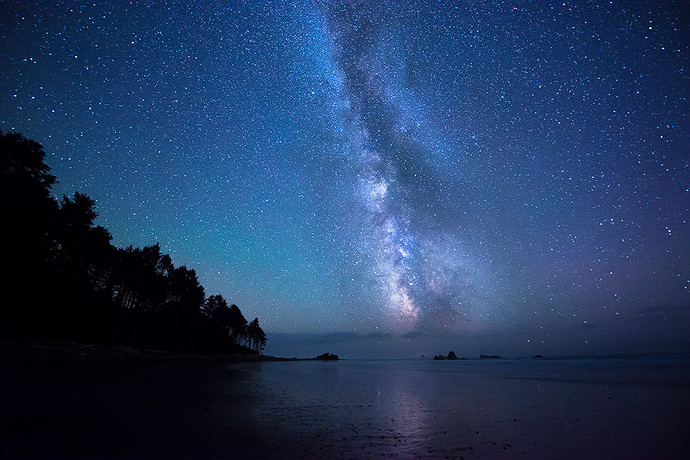Hey guys!
I’ll be heading up north (well sortof), to the Muskoka region of Ontario this weekend to visit a friend’s cottage (cabin for the Americans out there). I am wondering what your experiences with Open Source star trail stacking software are and if you have any tips or tricks I may want to keep in mind (such as what to set exposure to and such).
Any info is greatly appreciated! 
I’m not very experienced with capturing star trails. But I can try to offer a few tips:
Experiment with your camera a bit to find a combination of exposure time and ISO that works well.
At least with the cameras I own that’s not ISO 100. Shorter exposures + stacking work better. ~ISO 400 + ~1 Minute exposures would be a starting point but that of course also depends on the aperture of your lens. Stop down a bit to reduce optical issues.
If you are using a DSLR don’t forget to close or cover the viewfinder.
Capture darkframes both before & after.
Err on the side of under exposing rather than overexposing. With 14 bit raw files you can afford to lose some bit depth. Clipping on the other side is mostly irreversible and will make your image look flat (all the stars end up at the same brightness)
For stacking there are multiple approaches, ‘lightest’ seems to be very popular for star trails. For the foreground try a mean or median.
I hope at least some of these are helpful.
2 Likes
Any programs you found work well?
Essentially the same tools I would otherwise use. The nice thing with star trails is that the alignment step falls away.
For developing the Raws I generally use RT or DT then export to (16 bit) tiff. In this case I would probably go with RT because it has support for darkframes and more suitable denoising algorithms (lgv/lmmse) built in.
For quick stacking I often just use Image Magick.
To get the mean: convert input-*.tiff -evaluate-sequence mean output.tiff
And for max convert input-*.tiff -evaluate-sequence max output.tiff
The thing this cannot do which dedicated software can is filling in holes in star trails, but if you work carefully you should not have any. 
I’m also searching for the best software to get things like this done:
(not interested so much in star trails but static night sky photos like this one)
stacking method ofc, because I don’t want to spend a fortune for a camera + lens combo
From little research I’ve done over the internet Siril, Hugin or MacroFusion would be the best open source software packages to use, tho I haven’t found any step by step tutorial how to do this. people seem to have done things like this to good success.
Basic steps:
- use ISO not higher than 800
- adjust exposure time to match your lens
- get about 10 or so exposures
- get a good exposure of ground (you can use shutter speed necessary for this to get 1 exposure right cause the ground aint moving)
- align stars in PP and mask ground for star exposures
- mask stars and align ground for the ground exposure
- blend all and voila
Hope that someone with better editing skills than mine will make a step by step tutorial for some of the software 
1 Like
I still plan to write down my process but I have been putting it off since I first want to have a nice example ‘dataset’.
Sadly the milkyway season here is almost over again and except for my ‘urban astrophotography’ I haven’t been able to take any decent astro photos this year. 
This is awesome @Jonas_Wagner @Trickortreat I will try these techniques and hopefully succeed 



